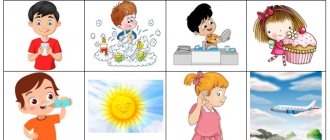Some children do not pronounce whistling sounds that are difficult for them. For example, instead of S, they say Сь, instead of З – Зь, and so on. Sometimes whistlers disappear completely from pronunciation. Normally, upon reaching five years of age, a child can already pronounce all sounds correctly, especially if they were taught in kindergarten or by their parents. Children in kindergarten should be given articulation exercises every morning in the morning, and a speech therapist should work with children on the individual characteristics of the child’s sound reproduction. This is not always the case in kindergartens. A strictly structured system is not followed, without which this problem cannot be solved.
In order to help your child eliminate deficiencies in the pronunciation of the letters S, Z and C, you yourself need to understand exactly what the correct articulation is when pronouncing them. Staging these sounds is painstaking work that requires long-term attention. If you approach the question “He will speak out on his own” or “What difference does it make that the child does not pronounce letters, he is small, and this is so cute,” then you can limit the child in one of the most important human needs - to express himself. After all, speech is a means through which self-expression occurs.
The baby does not pronounce whistling sounds, when should we start combating this phenomenon?
If you wait until the age of five to take your child to a speech therapist, you may be late, the child will develop incorrect pronunciation, and it will be increasingly difficult for him to change anything. It doesn't take an expert to understand that babies need to create a trigger to begin pronouncing sounds correctly. And it’s better to do this at 4 years old. Many parents cope with their child’s speech defects themselves, without the participation of speech therapists.
If the baby does not have serious speech disorders, then producing whistling sounds will not be difficult. All you have to do is follow the recommendations of this article so that your child will soon delight you with a ringing Z and other correctly placed sounds. Once this skill has been achieved once, your task will be to consolidate the skill, that is, to bring it to the level of automaticity.
If your baby’s sounds are impaired, he speaks incomprehensibly, or only you can understand it, you cannot ignore a speech therapist. It would be impossible to do without his participation. The earlier you come to your first conversation with a speech therapist, the faster the results will be achieved and consolidated.
All the following exercises will be useful not only for kids, but also for school-age children, and even for parents themselves, since articulatory gymnastics at any age develops the speech apparatus, makes it more pliable, flexible, teaches how to control it perfectly, and how to control it according to at your own discretion.
Step-by-step work is the most important thing in the fight against poor pronunciation. How to competently approach the issue of setting sounds and what you need to understand for yourself:
- Awareness and understanding of all movements of the organs of the speech apparatus that are needed to pronounce a certain sound.
- The emergence of the correct sound.
- Consolidating the given sound in the child’s spoken speech, both in individual syllables and in entire phrases and rhymes.
Let's start with an articulatory warm-up!
A child who mispronounces one of the whistles will probably mispronounce the rest of them, by analogy with the first one. The most common reason for the incorrect pronunciation of these sounds is the inflexibility of the organs that are involved in its reproduction. This is why regular exercise is so important. Mobility is not achieved with one lesson, but is developed with each new lesson. There should be no breaks in daily exercise.
The best time is morning. To conduct the lesson you only need three minutes of time before breakfast. Always teach your children in the form of games. To conduct articulation warm-ups you need to know several rules:
- Perform no more than 2-3 exercises at a time, but each exercise is repeated many times.
- Do not introduce more than one new exercise at a time; if there are difficulties with the old exercises, it is forbidden to include a new one in the process until the old one has been worked out.
- A mirror is the best assistant when working on correct articulation. All your movements and the work of the baby’s speech apparatus should be visible to the child, so that he has the opportunity to compare what he sees in you and in himself.
- Not just any exercise – there is gymnastics! If you came to training and lazily waved your arms, you will never be successful. It’s the same when working with pronunciation: all exercises must be done well.
- Do not scold your child for those moments when he does not succeed, especially do not be upset yourself. Everything requires skill. Praise your child for any correctly performed movement.
Other restrictions due to coronavirus
During non-working days, all public institutions in the capital and region will be closed. This applies to:
- restaurants, cafes and other catering facilities;
- cinemas;
- shopping centers;
- beauty salons;
- non-food stores.
All employees of these facilities will be sent on forced leave. The restrictions apply even to those who have completed the full course of vaccination and have the appropriate QR certificate in hand.
Please note that theaters and museums will continue to welcome guests. True, only those vaccinated against COVID-19. Special operating hours include limiting the number of visitors.
Public places will open only on November 8, according to preliminary information. However, this requires that the number of people infected with coronavirus decrease significantly. If the epidemiological situation improves, vaccinated citizens will again be able to visit cinemas, shopping centers, cafes and other public places.
Articulation complex exercises
At home or in kindergarten, but it is better to start with the following set of exercises:
- We make a long tube with our lips, try to pull it out as far as possible, and hold it for as long as possible. We make sure that only one lips are working.
- We stretch our mouth into a smile. With this exercise, the teeth are clearly visible and the lips are stretched as much as possible. We keep smiling until our lips become tired.
- We make a ring from the lips and again hold them in this tense state.
- We alternate this chain: tube - ring - smile - tube - ring - smile and so on.
- In the smile position, open and close your mouth. It is important that the lips do not make any extraneous movements.
- We stick our tongue out of the slightly open mouth and ensure that the tongue becomes flat.
- The same exercise, but we achieve a sharp and narrow shape of the tongue.
- We combine the previous two exercises and force the tongue to alternately take a wide and narrow shape. We alternate actions.
- Raise your tongue and hide it behind your upper teeth.
- We alternately raise the tongue to the upper palate and lower it to the lower palate. We repeat many times.
- Press the tip of the tongue against the lower palate near the teeth and make the tongue “stagger”, either going deeper into the mouth or approaching the teeth.
We check if the baby easily performs articulatory exercises, then move on to sound production complexes. And if the baby has a very difficult time performing these movements, then we only train them for now before learning the sounds.
Remote work in Moscow and the region
The mayor of the capital had previously written in his blog about the restrictions that would be introduced due to the worsening epidemiological situation. He asked employers to transfer at least 30% of their staff to remote work. The following categories must be sent remotely:
- people with chronic illnesses;
- citizens aged 60 years and older;
- people who have not been vaccinated against COVID-19.
Earlier, on October 25, a home regime for pensioners was introduced. They must go into self-isolation. At the same time, walking and physical exercise in the fresh air are not prohibited. The stay at home order will last until February 25, 2022. Pensioners who have had coronavirus over the past six months or have completed a full course of vaccination are exempt from it.
Please note that the remote employment regime will also continue until February 25. However, this does not apply to employees working in critical businesses and healthcare facilities.
A set of exercises for clear pronunciation of the sounds C, Z, S
Before performing the exercise, tell your child in words how the tongue should move, and watch how the baby performs them. Kids won't be upset by the mistakes they make if you treat them with humor. A common mistake can be puffing out your cheeks. Let the baby hold his cheeks with his hands so that they do not puff up.
Goal!
The first important skill when producing the C sound is to learn how to reproduce a long, continuous stream of air. Place two elements of the construction set or cube on the table - these will be the gates. Place a cotton ball in front of them. The baby must stretch out his lips, fold them into a tube and use a stream of air to push the ball into the goal. Cheeks should not puff up! The air supply occurs not through the cheeks, but from the lungs.
The tongue lay down to rest
We open our mouth slightly and, with the help of lightly patting our lips, say “five five five five.” Now we show a relaxed, flat, wide tongue from the mouth and place it on the upper lip. We do “five five five five” directly along the back of the tongue - this is a massage for the resting tongue. Each pat of the tongue with the lips should be done with one exhalation.
Pancake tongue
Teach your child to hold his tongue in a relaxed position and stick out for as long as possible. It is important that your lips should not tense or curl up. The sides of the tongue should touch the corners of the mouth - a wide tongue.
Clean teeth
Use the tip of your tongue to “clean” all the teeth in your mouth. Pay attention to both the “backs” of the cloves and their outer surface. This exercise is especially important when it is necessary to produce the sound C. Make sure that your lips are motionless during the exercise and stretched in a calm smile.
Let's make friends with the sound C!
If you correctly organize the work of the articulatory apparatus, then when pronouncing C, the lips should stretch into a smile, and the teeth should form a thin gap. In this case, the tip of the tongue is tightly pressed against the base of the lower teeth, and the tongue itself is curved, like the back of a cat. For the sound to “work”, the air stream must be strong and narrowly directed.
A child sometimes makes mistakes. What are the most common mistakes you see?
- Instead of C we hear other sounds.
- The sound C completely disappears from words.
- It is pronounced S, but sounds distorted, such as soft.
When you are sure that the child's mouth has taken the exact position for reproducing C, then start by imitating in front of the mirror, as mentioned above. Play with the C sound - for example, blow away specks of dust or fluff. A great method that can be used in this exercise is reference sounds. For S, there are two reference sounds that you need to learn to speak in order to pronounce S: these are I and F.
As soon as the child can master C separately, he needs to move on to words and sentences, and in the final final stage, use tongue twisters.
Calling Z is on our shoulder!
Z is very similar to the previous C in terms of the arrangement of parts of the articulatory apparatus. The only difference is that when pronouncing a voiced Z, you need to add a voice. Don't start practicing Z until you have made the S sound. Place your child's hand on the vocal cord area of the neck and say S and Z in turn. When pronouncing Z, the baby will feel vibration, but when saying C it is absent. This vibration is produced by the sound stream, that is, the voice.
As the baby develops the sound Z more and more clearly, ask him to say it louder. And then move on to integrating Z into words and sentences.
When the letter "z" is written in prefixes
Before the voiced consonant at the root of the word, the letter “z” is written at the end of the prefix.
For example:
- joyless , _
- reward , _
- glance at _
- from product ,
- down to the bottom,
- obez g catch,
- Christmas time ,
- rose , _
- over moderation .
Note.
Only the prefix s- does not obey this rule. It is always written in a word, regardless of which consonant the root begins with.
Example: ruin, surrender, cut off.
Note.
In the Russian language there is no prefix z-, but there are words with the initial root consonant “z”.
Example: building, hello, here.
Remember!
There is no prefix Z- in the Russian language ! There is only the prefix S- Burn Escape Sing Make
Note.
There is a so-called “pitfall” in writing these words: unrealizable, inflexible, intractable, undeliverable, fireproof, not good enough.
Among these words there is no prefix un-, but there is a prefix niz-/nis-. This means that in the morphemic composition of these words there is not one, but two prefixes:
Thus, the prefix s- is hidden in the middle of the word. Even though a “z” is heard at the root before a voiced consonant, the prefix s- is still written.
Ts – cheerful sound and friend!
The sound C is related in articulation to Z and S. And the sound C consists of two sounds - T and S. Therefore, when pronouncing it, we must teach the child to correctly reproduce both of these sounds at the beginning.
When pronouncing C, the air wave is quite strong. Usually C is given to children simply, since it is based on the pronunciation of previously learned C. You can automate the sound using special verses, which a specialist will suggest to you.
Working on making sounds for babies is an exciting and fun process. Do not try to teach the child, it is better to play with him, then the result will be much more productive.
Video with articulatory gymnastics for clear pronunciation of whistling sounds (s, z, z):
Problems with the pronunciation of whistling sounds “s, z” or “lisp”
Home — About speech therapy — Whistling sound disorders
In this article we will continue the conversation about lisps, but we will dwell in more detail on the distorted “lisp” pronunciation of the sounds “s, z”. The term “lisp” refers to the incorrect pronunciation of sounds, which is accompanied by hissing, whistling and other “noisy” tones.
Usually, young children pronounce whistling sounds softly at first (example: dog - “syabaka”, teeth - “zyuby”), but by the age of 3.5-4 years, the firm pronunciation of whistling sounds should be successfully mastered. To correctly pronounce the sounds “s, z” you need the following:
- The lips are half-opened, in a smile;
- The teeth are clenched or tightly brought together, so that the distance between the teeth is 1-2 mm;
- The tongue is wide, the tip of the tongue rests on the lower teeth, and a groove is formed along the midline of the tongue through which air passes.
If there are irregularities in the structure of the teeth, the tongue is poorly mobile, tense or overly relaxed, defects in the pronunciation of whistling sounds may occur - a lisp.
The lisp pronunciation of the sounds “s, z” is divided into 2 main forms:
1. The most common types of distortions are: Distorted pronunciation of whistling sounds or their absence - the scientific name is “sigmatism”.
- Interdental pronunciation - the tip of the tongue is pushed between the teeth, and a lisping tone appears;
- Dental pronunciation - the tip of the tongue rests against the teeth, interfering with the free passage of air. And you hear “t,d.” Example: dog - tobacco, teeth - oaks.
- Hissing pronunciation - the tip of the tongue rests on the lower gums or is slightly pulled away from them, and the back of the tongue is curved into a hump. A soft hissing sound is heard, like a “sh”. Example: a dog is shabaka, teeth are juby.
- Labial-dental pronunciation - the lower lip touches the upper incisors, like the sound “f”, a snorting sound is obtained. Example: dog - fabaka, teeth - fuba.
- Lateral pronunciation - with this option, the tip of the tongue or the entire half of the tongue is pulled to the side, resulting in a noisy, lisping sound, or the tip of the tongue is raised up, and air passes between the cheek and sides of the tongue (a squelching sound like “lch” is obtained).
- Nasal pronunciation - with this defect, the soft palate does not sufficiently cover the exit to the nasal cavity and a nasal tone of sound is heard, as with a runny nose.
2. Replacement of whistling sounds with others is the scientific name “parasigmatism.”
Most often, whistling sounds are replaced with “s, z”, “sh, zh” (example: dog - sabaka, shabaka), however, there are also completely atypical replacements with the sounds “t, x, g” (example: dog - habaka, teeth – lips, sleds – tanks, etc.). Only substitutions with “sing, z” up to 3-3.5 years are normal, typical, and there is a high probability that the child will independently learn to pronounce whistling sounds correctly. If atypical, jarring sound changes immediately appear, then parents should pay attention to this and make an appointment with a speech therapist.
It is best for children to start attending speech therapy at age 5
– by this age, the child can already control himself and is better aware of the movement of the muscles of the lips and tongue.
If it was not possible to correct a lisp in childhood, then this defect remains and we often hear it in the speech of adults and adolescents.
Mostly in adults and adolescents, interdental pronunciation is observed due to the incorrect structure of the teeth and bite (especially anterior open bite, when there is a hole between the teeth and the tip of the tongue is constantly sticking out). After treatment by an orthodontist and wearing braces, the teeth are already closed, but the habit of sticking the tongue between the teeth and lisping remains. Then you cannot do without the help of a speech therapist. During the classes, a specialist will show you how to position your tongue and teeth correctly, and then help you introduce a new correct sound into speech.
From practical experience:
Zhanna, 27 years old: had a malocclusion, is completing treatment with an orthodontist, wears braces. 6 sounds are broken, including “s, z”. In 4 lessons, I learned to pronounce these sounds correctly and already actively uses them in speech (she constantly practices at home, actively uses new sounds at work when communicating with colleagues and clients).
If a lisp prevents you from fully communicating and causes embarrassment when communicating, then it is never too late to make an appointment with a speech therapist who will help you gain beautiful, clear speech.





